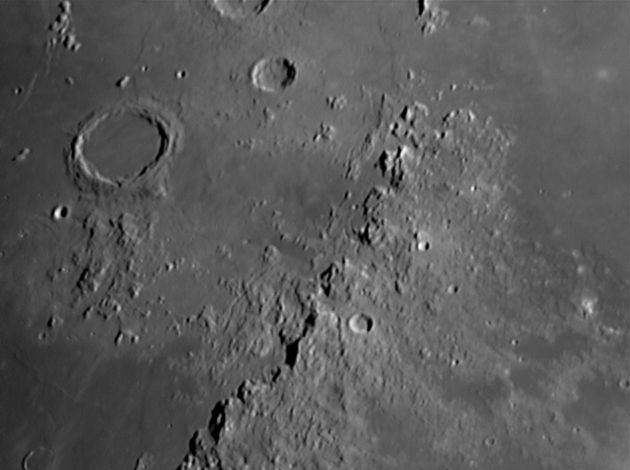The Apennine Mountains 
Move your mouse over the picture to see the names of the various features.

|
This picture of Archimedes and the Apennine mountains was taken in what would be the late morning on the Moon.
Archimedes is the largest crater here, 85 Km in diameter and 2100 metres deep.
It is fairly old by lunar standards at about 3,500 million years and it has been flooded
by lava as attested to by the flat floor and lack of a central mountain. Autolycus,
on the other hand, is less than 1,000 million years old, is 41 Km in diameter and 3400 metres
deep. It has central mountains but they don't show up well in this picture due to the high Sun.
The Apennine mountains themselves form the south-western rim of the Mare Imbrium. They
are 980 km long and rise to 5400 metres (Mons Huygens). At the northern end of the range,
between Mons Hadley (4800 metres) and Mons Hadley Delta is the landing site of Apollo 15
close to Hadley Rille which doesn't show up in this picture (but see my
Apollo 15 page). I was pleased at how many of the
mountains here I was able to find names for, along with two Laci (Lakes) and the charmingly
named Palus Pudridinis (the Putrid Marsh).
The scale markers are approximately 100 km long north and east.
The picture was taken with a ToUcam attached to my LX200 on 5th March 2005, when the Moon was 9.1 days old.
|
| Date and Time |
5th March 2005 19:40 UT |
Camera |
ToUcam 740K |
Telescope |
LX200 at prime focus |
Capture |
K3CCDTools. High gamma, 1/100", 9% gain, 308 frames |
Processing |
Registax. 74 frames stacked. Wavelet 1-2 = 10 |
Home Back to NE Quadrant


